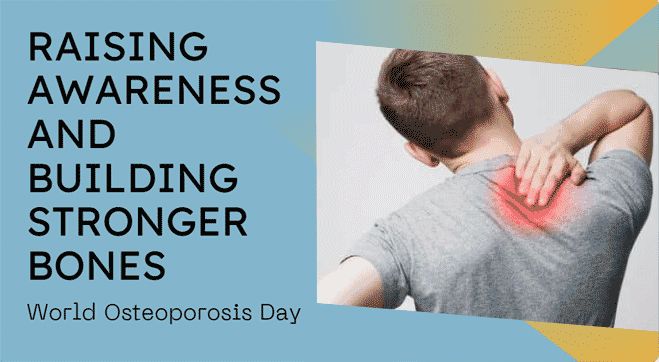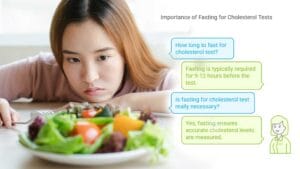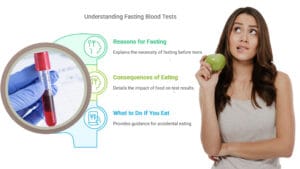October 20th is recognised worldwide as World Osteoporosis Day, an occasion dedicated to raising awareness about osteoporosis and providing essential information on its prevention. We aim to share insights into the purpose of the day and the latest osteoporosis statistics. In addition, we have compiled key information on osteoporosis symptoms, risk factors, prevention strategies, diagnosis, and treatment options. Read on to learn more.
Did you know:
- Data collected from 2017 to 2018 indicates that osteoporosis is a common problem worldwide among people of all genders.
- Likewise, the prevalence rate of osteoporosis in older adults, particularly those over 50, was shown to be 12.6%. Most of these people had either hip or spine osteoporosis, and some even had both hip and spine osteoporosis at the same time.
- Moreover, osteoporosis prevalence was found to be higher in females than males. This is because the data indicated that 19.6% of females had osteoporosis in comparison to only 4.4% of males. 1
Understanding Osteoporosis
Before understanding more about the goals of World Osteoporosis Day, it is essential to know what is osteoporosis and what its symptoms actually look like. So, here is a quick overview –
What Is Osteoporosis?
Osteoporosis is a medical condition that affects your bone health. Likewise, if you have osteoporosis, then there is a decrease in your bone mass and a degradation in your bone health. As a result, your chances of undergoing bone fractures, even with a minor injury, increase significantly. This happens due to decreased bone density.
Based on the main cause, osteoporosis is classified into the following 2 types—
- Primary Osteoporosis: This is the most common type and is reported in adults over 70 and postmenopausal women.
- Secondary Osteoporosis: Long-term use of specific medicines or the presence of some other serious medical condition leads to the development of secondary osteoporosis.
Osteoporosis Symptoms
Osteoporosis is sometimes known as ‘a silent disease’. This is because it does not show as obvious symptoms as other medical conditions. Most of the time, you won’t even realise that you have this bone disorder because there are no clear-cut signs. However, the only situation that can be considered as one of the symptoms of osteoporosis is the breaking of a bone after a minor injury, in which a bone wouldn’t break generally.
Other osteoporosis symptoms or warning signs can include the following:
- Postural changes. You might find yourself stooping or frequently bending forward more than usual.
- Height reduction (only by one or half an inch)
- Shortness of breath (or difficulty in breathing)
- Pain in your lower back (especially near or above your hip area)
Hence, if you notice any of the above changes in your body, then you might need a professional osteoporosis diagnosis. Moreover, it is better to ask your family members to keep a check on your body posture and height, as they can observe these osteoporosis symptoms better than you can. 2
Osteoporosis Risk Factors
Osteoporosis risk factors refer to conditions in which the chances of developing osteoporosis symptoms increase compared to a normal, healthy person.
The main osteoporosis risk factors include the following:
- Older adults because bone density decreases with age
- Women
People belonging to white and Asian races - Having a close relative, such as a parent or a sibling who already has osteoporosis. In this case, your osteoporosis risk factor would be higher, especially if your mother or father has undergone a hip fracture.
- People with a smaller body frame. This applies to both men and women. 3
Osteoporosis Diagnosis and The Importance of Early Detection
An Osteoporosis diagnosis includes the examination of your bones to check your bone density and bone mineral levels using X-rays (low-intensity X-ray radiations). It is a simple and painless test, which involves the passing of a scanner over your body after you lie down on a padded table.
In maximum cases, only some bones (that is, the ones that are at a higher risk of damage, for example, your hip and your spinal cord) are diagnosed for their health status during an osteoporosis diagnosis.
But the biggest question is, who should get an osteoporosis diagnosis? In the above section, we have mentioned the osteoporosis risk factors, which include people who are at higher risk.
To become a part of World Osteoporosis Day, you can create osteoporosis awareness by encouraging people at risk to opt for an osteoporosis diagnosis.
Osteoporosis Prevention Tips
One of the key elements of spreading osteoporosis awareness on World Osteoporosis Day is to understand and make people aware that the risk of osteoporosis increases with age. However, if you adopt the right osteoporosis prevention methods from a young age, then you can delay the onset of osteoporosis symptoms.
So, here are some great osteoporosis prevention tips—
1. Best Exercises for Osteoporosis
Osteoporosis prevention includes the incorporation of a healthy diet, especially one rich in vitamin D and calcium, and increasing physical activity to improve bone density.
That is why here is a list of some of the best exercises for osteoporosis—
- Walking
- Running
- Strength training
Remember that you must perform these exercises regularly to minimise your chances of developing osteoporosis symptoms with maximum efficiency.
2. Eat A Balanced Diet
To prevent osteoporosis symptoms, it is important to regularly perform the best exercises for osteoporosis. But along with these, it is equally important to have a balanced and nutrient-rich diet that comprises enough—
- Protein
- Calcium
- Vitamin D
Among these, the benefits of Vitamin D for osteoporosis and calcium to improve bone health are numerous. In fact, whether you have an osteoporosis diagnosis or not, eating a healthy and balanced diet should be your first priority for your long-term health.
3. Sun Exposure for Vitamin D And Osteoporosis
Since ancient times, the sun has been used as the ultimate and one of the most powerful sources of vitamin D. Basking under the sun for a short duration daily is, therefore, one of the best osteoporosis prevention methods.
4. Avoid Smoking and Minimise Alcohol Abuse
While smoking decreases bone density, alcohol limits your body’s ability to absorb calcium properly. That is why, to prevent the development of osteoporosis symptoms, you must avoid or at least minimise your alcohol use and reduce smoking.
5. Vitamin D For Osteoporosis Prevention
Vitamin D and osteoporosis have a direct relationship because vitamin D helps your body to absorb calcium from your diet. Apart from staying under the sun for at least 15 minutes a day, you can also opt for vitamin D-rich foods for osteoporosis prevention.
Here are a few good examples—
- Fortified milk
- Egg yolks
- Salmon 4
6. Calcium For Bone Health
Calcium for bone health is of great importance because it helps in the maintenance of strong and healthy bones. Thus, calcium-rich foods make an important component of the osteoporosis prevention diet.
Here are a few good examples—
- Dairy products (low-fat)
- Broccoli
- Beans or legumes
- Collard greens
- Kale
- Almond milk
- Fortified foods. For E.g., bread and cereal
How To Treat Osteoporosis Symptoms?
The treatment for osteoporosis symptoms usually revolves around the use of hormone therapy for osteoporosis. But if you’re wondering what is hormone therapy for osteoporosis, and how it works, this is what you need to know:
Hormone Therapy for Osteoporosis
Hormone therapy revolves around the treatment of osteoporosis symptoms by using several drugs that help to fix certain hormonal levels in the body. These drugs help stimulate hormones like oestrogen so that they can support bone growth.
Some examples of medicines that are given during the hormone therapy for osteoporosis include—
- Oestrogen
- Parathyroid Hormone (PTH) For e.g. Teriparatide
- Parathyroid Hormone-Related Protein. For e.g. Abaloparatide
- Raloxifene (Evista)
Apart from hormone therapy, there are certain other medicines that don’t necessarily form a part of hormone therapy for osteoporosis but are equally great at treating osteoporosis symptoms. These include—
- Bisphosphonates
- Calcitonin
- Vitamin D and calcium supplements
Living with Osteoporosis: 3 Beneficial Management Tips
After getting an osteoporosis diagnosis, it becomes crucial to adopt the right osteoporosis symptoms management techniques in order to live a healthy and fulfilling life with the disease. Hence, here is a list of some helpful lifestyle changes that work well towards osteoporosis prevention and worsening in case of people who already have it—
1. Quit smoking
The more you smoke, the weaker your bones become. That is why one of the most essential elements of osteoporosis awareness on World Osteoporosis Day is to encourage people with osteoporosis, along with those who are at risk for it, to quit smoking.
2. Exercise Daily
Let us discuss in brief about the best exercises for osteoporosis in this section.
When you exercise, your bones become stronger, and your muscles become more powerful. As a result, your overall body coordination improves, resulting in fewer chances of falling. Since people with osteoporosis are at a greater risk for bone breakage due to minor falls, exercising daily works excellently well to minimise its chances.
3. Diet And Supplements with Vitamin D And Calcium for Bone Health
To maintain the strength of your bones and deal with osteoporosis symptoms, you must regularly eat a diet full of vitamin D and calcium, as both of these are crucial for bone health.
Along with this, you can also ask your medical expert to recommend vitamin D and calcium supplements as per your needs to minimise long-term risks associated with osteoporosis. 5
All in all, performing the best exercises for osteoporosis, taking enough vitamin D and calcium for bone health, avoiding alcohol abuse, and quitting smoking can help you lead an early lifestyle with osteoporosis.
Global Initiatives for World Osteoporosis Day
The primary aim of the global initiatives for World Osteoporosis Day involves generating osteoporosis awareness by taking into consideration osteoporosis statistics and letting people know the risks associated with the disease.
That is why the World Osteoporosis Day Theme 2024 was designed to support the banner ‘Say no to fragile bones. The idea behind this slogan is to inform the general public about—
- Osteoporosis symptoms and how to identify them?
- Osteoporosis risk factors
- Why is it so essential to get timely osteoporosis treatment?
- Osteoporosis prevention and management tips
- The importance of early diagnosis of osteoporosis
- How do I live a healthy and fulfilling life with osteoporosis?
Conclusion
To summarise, World Osteoporosis Day offers you a great opportunity to participate in campaigns that promote bone health awareness and extend support to people who are already suffering from osteoporosis.
Hence, if you want to participate in World Osteoporosis Day, one of the best ways is to inform people at risk about their higher potential of developing osteoporosis symptoms. You can also give them osteoporosis prevention tips and refer them to an osteoporosis diagnosis so that they can get the best treatment on time.








